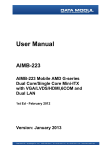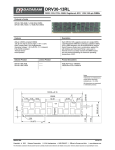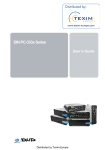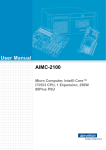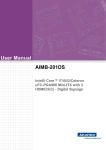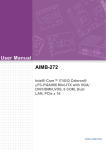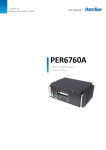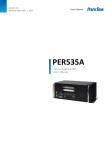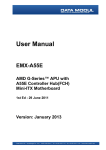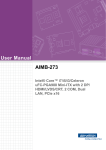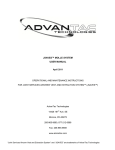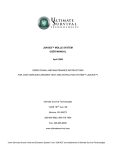Download User Manual AIMB-223
Transcript
User Manual AIMB-223 AIMB-223 Mobile AMD G-series Dual Core/Single Core Mini-ITX with VGA/LVDS/HDMI,6COM and Dual LAN Copyright The documentation and the software included with this product are copyrighted 2012 by Advantech Co., Ltd. All rights are reserved. Advantech Co., Ltd. reserves the right to make improvements in the products described in this manual at any time without notice. No part of this manual may be reproduced, copied, translated or transmitted in any form or by any means without the prior written permission of Advantech Co., Ltd. Information provided in this manual is intended to be accurate and reliable. However, Advantech Co., Ltd. assumes no responsibility for its use, nor for any infringements of the rights of third parties, which may result from its use. Acknowledgements AWARD is a trademark of Phoenix Technologies Ltd. IBM and PC are trademarks of International Business Machines Corporation. Intel® Atom™ N455/D525 is trademark of Intel Corporation WinBond is a trademark of Winbond Corporation. All other product names or trademarks are properties of their respective owners. AIMB-223 User Manual Part No. Edition 1 Printed in Taiwan April 2012 ii A Message to the Customer Advantech Customer Services Each and every Advantech product is built to the most exacting specifications to ensure reliable performance in the harsh and demanding conditions typical of industrial environments. Whether your new Advantech equipment is destined for the laboratory or the factory floor, you can be assured that your product will provide the reliability and ease of operation for which the name Advantech has come to be known. Your satisfaction is our primary concern. Here is a guide to Advantech’s customer services. To ensure you get the full benefit of our services, please follow the instructions below carefully. Technical Support We want you to get the maximum performance from your products. So if you run into technical difficulties, we are here to help. For the most frequently asked questions, you can easily find answers in your product documentation. These answers are normally a lot more detailed than the ones we can give over the phone. So please consult this manual first. If you still cannot find the answer, gather all the information or questions that apply to your problem, and with the product close at hand, call your dealer. Our dealers are well trained and ready to give you the support you need to get the most from your Advantech products. In fact, most problems reported are minor and are able to be easily solved over the phone. In addition, free technical support is available from Advantech engineers every business day. We are always ready to give advice on application requirements or specific information on the installation and operation of any of our products. iii AIMB-223 User Manual Declaration of Conformity FCC Class B This device complies with the requirements in part 15 of the FCC rules: Operation is subject to the following two conditions: This device may not cause harmful interference This device must accept any interference received, including interference that may cause undesired operation. This equipment has been tested and found to comply with the limits for a Class B digital device, pursuant to Part 15 of the FCC Rules. These limits are designed to provide reasonable protection against harmful interference when the equipment is operated in a commercial environment. This equipment generates, uses, and can radiate radio frequency energy and, if not installed and used in accordance with the instruction manual, may cause harmful interference to radio communications. Operation of this device in a residential area is likely to cause harmful interference in which case the user will be required to correct the interference at his/her own expense. The user is advised that any equipment changes or modifications not expressly approved by the party responsible for compliance would void the compliance to FCC regulations and therefore, the user's authority to operate the equipment. Caution! There is a danger of a new battery exploding if it is incorrectly installed. Do not attempt to recharge, force open, or heat the battery. Replace the battery only with the same or equivalent type recommended by the manufacturer. Discard used batteries according to the manufacturer's instructions. AIMB-223 User Manual iv Memory Compatibility Test Item Brand Description Size Speed Type ECC Vendor PN Memory Advantech Result Remark PN SODIMM N DDR3 SEC TS128MS K4B1G08 96SD3K64V1U/ 46D1G1066NN- PASS TS2KSU2 HCF8(12 TR 8200-1S 8x8) SODIMM N DDR3 SEC HCH9 96SD3TS128MS K4B1G08 1G1066NN- PASS K64V1U 46D(128x TR 8) SODIMM N DDR3 SEC TS256MS K4B1G08 96SD3K64V1U/ 46D2G1066NN- PASS TS5KSU2 HCF8(12 TR 8400-1S 8x8) SODIMM N DDR3 SEC HCH9 96SD3TS128MS K4B1G08 2G1066NN- PASS K64V1U 46D TR (128x8) SODIMM Transcend 4GB DDR31066 N DDR3 HYNIX 96SD3TS7KSN2 H5TQ2G 4G1066NN- PASS 8420-1Y 83BFR TR (256x8) Transcend 1GB DDR31066 Transcend 1GB DDR31066 Transcend 2GB DDR31066 Transcend 2GB DDR31066 Apacer SODIMM 1GB DDR31066 N DDR3 ELPIDA 96SD378.02GC3 J1108BD Limita1G1066NN.420 BG-DJ-F tion AP (128x8) Apacer SODIMM N 2GB DDR31066 DDR3 ELPIDA 96SD378.A2GC3 J1108BA 2G1066NN- PASS .421 BG-AEAP E(128x8) Apacer SODIMM N 4GB DDR31066 DDR3 HYNIX 96SD378.B2GC8 H5TQ2G 4G1066NN- PASS .AF1 83BFR AP (256x8) Kingston 2GB DDR31066 SODIMM N DDR3 KVR1066 KVR1066 D3S7/2G D3S7/2G (256x8) DSL SODIMM 1GB DDR31066 N DDR3 ELPIDA J1108BA SE-DJ-E (128x8) DSL SODIMM 4GB DDR31066 N DDR3 HYNIX D3SH560 H5TQ2G 82XH18A 83BFR B (256x8) PASS Micron SODIMM 1GB DDR31066 N DDR3 Micron MT8JSF1 9FF27 2864HZD9KPT 1G1F1 (128x8) PASS v PASS Limitation AIMB-223 User Manual Samsung G.SKILL 2GB DDR31066 4GB DDR31066 Transcend 1GB DDR31333 Transcend 2GB DDR31333 SODIMM N DDR3 SEC 904 M471B56 HCF8 73DH1K4B1G08 CF8 46D (128x8) PASS SODIMM N DDR3 HYNIX F3H5TQ2G 8500CL7S 83AFR-4GBSQ G7C(256 X8) PASS SODIMM N DDR3 SEC 849 HCH9 TS128MS K4B1G08 K64V3U 46D (128x8) PASS SODIMM N DDR3 SEC 904 HCF8 TS256MS K4B1G08 K64V3U 46D (128x8) PASS HYNIX TS512MS H5TQ2G K64V3N 83BFR (256x8) PASS SODIMM Transcend 4GB DDR31333 N DDR3 Apacer SODIMM 1GB DDR31333 N DDR3 ELPIDA 96SD378.02GC6 J1108BD Limita1G1333NN.420 BG-DJ-F tion AP (128x8) Apacer SODIMM N 2GB DDR31333 DDR3 ELPIDA 96SD378.A2GC6 J1108BD 2G1333NN- PASS .421 BG-DJ-F AP (128x8) Apacer SODIMM 4GB DDR31333 N DDR3 HYNIX 78.B2GC9 H5TQ2G .AF1 83BFR (256x8) PASS DSL SODIMM N 1GB DDR31333 DDR3 ELPIDA D3SE280 J1108BD 81XH15A SE-DJ-F A (128x8) Limitation DSL SODIMM 2GB DDR31333 N DDR3 ELPIDA D3SE280 J1108BD 82XH15A SE-DJ-F A (128x8) PASS DSL SODIMM 4GB DDR31333 N DDR3 HYNIX D3SH560 H5TQ2G 82XH15A 83BFR A (256x8) PASS Kingston SODIMM 1GB DDR31333 N DDR3 E LPIDA KVR1333 J1108BD D3S9/1G BG-DJ-F (128x8) Limitation Kingston SODIMM 2GB DDR31333 N DDR3 E LPIDA KVR1333 J1108BD D3S9/2G BG-DJ-F (128x8) PASS SODIMM N DDR3 SEC 019 HCH9 AW12M64 K4B2G08 F8BKH9S 46C (256x8) PASS ATP 4G B DDR31333 AIMB-223 User Manual vi Ordering Information Part Number CPU SC/DC GbE COM LVDS AIMB-223G2-S0A1E T44R Single core 2 6 1, 24/48bit AIMB-223G2-S1A1E T40E Dual core 2 6 1, 24/48bit AIMB-222G2-S2A1E T56N Dual core 2 6 1, 24/48bit Product Warranty (2 years) Advantech warrants to you, the original purchaser, that each of its products will be free from defects in materials and workmanship for two years from the date of purchase. This warranty does not apply to any products which have been repaired or altered by persons other than repair personnel authorized by Advantech, or which have been subject to misuse, abuse, accident or improper installation. Advantech assumes no liability under the terms of this warranty as a consequence of such events. Because of Advantech’s high quality-control standards and rigorous testing, most of our customers never need to use our repair service. If an Advantech product is defective, it will be repaired or replaced at no charge during the warranty period. For outof-warranty repairs, you will be billed according to the cost of replacement materials, service time and freight. Please consult your dealer for more details. If you think you have a defective product, follow these steps: 1. Collect all the information about the problem encountered. (For example, CPU speed, Advantech products used, other hardware and software used, etc.) Note anything abnormal and list any onscreen messages you get when the problem occurs. 2. Call your dealer and describe the problem. Please have your manual, product, and any helpful information readily available. 3. If your product is diagnosed as defective, obtain an RMA (return merchandise authorization) number from your dealer. This allows us to process your return more quickly. 4. Carefully pack the defective product, a fully-completed Repair and Replacement Order Card and a photocopy proof of purchase date (such as your sales receipt) in a shippable container. A product returned without proof of the purchase date is not eligible for warranty service. 5. Write the RMA number visibly on the outside of the package and ship it prepaid to your dealer. vii AIMB-223 User Manual Initial Inspection Before you begin installing your motherboard, please make sure that the following materials have been shipped: 1 x AIMB-223 AMD G-series mini-ITX motherboard 2 x SATA HDD cable 2 x SATA Power cable 1 x Serial port cable(1 to 4) 1 x I/O port bracket 1 x Startup manual 1 x Driver CD 1 x Warranty card 1 x CPU cooler If any of these items are missing or damaged, contact your distributor or sales representative immediately. We have carefully inspected the AIMB-223 mechanically and electrically before shipment. It should be free of marks and scratches and in perfect working order upon receipt. As you unpack the AIMB-223, check it for signs of shipping damage. (For example, damaged box, scratches, dents, etc.) If it is damaged or it fails to meet the specifications, notify our service department or your local sales representative immediately. Also notify the carrier. Retain the shipping carton and packing material for inspection by the carrier. After inspection, we will make arrangements to repair or replace the unit. AIMB-223 User Manual viii Contents Chapter 1 General Information ............................1 1.1 1.2 1.3 Introduction ............................................................................................... 2 Features .................................................................................................... 2 Specifications ............................................................................................ 3 1.3.1 Processor System......................................................................... 3 1.3.2 Expansion Slot .............................................................................. 3 1.3.3 Memory ......................................................................................... 3 1.3.4 Graphic Interface .......................................................................... 3 1.3.5 Ethernet Interface ......................................................................... 3 1.3.6 SATA Interface.............................................................................. 3 1.3.7 EIDE.............................................................................................. 3 1.3.8 SSD............................................................................................... 3 1.3.9 Rear I/O ........................................................................................ 4 1.3.10 Internal Connector ........................................................................ 4 1.3.11 Watchdog Timer............................................................................ 4 1.3.12 Power Requirement ...................................................................... 4 1.3.13 Environment.................................................................................. 4 1.3.14 Physical Characteristics................................................................ 4 Jumpers and Connectors .......................................................................... 5 Table 1.1: Jumpers and Connectors ........................................... 5 Table 1.2: LVDS1 ........................................................................ 6 Table 1.3: JBL3: Panel VDDSAFE PWR..................................... 7 Table 1.4: JBL1: LVDS Inverter PWR ......................................... 7 Table 1.5: JBL8: BL controller from SIO...................................... 7 Table 1.6: JBL6 ........................................................................... 7 Table 1.7: JBL6 ........................................................................... 7 Table 1.8: JWDT1+JOBS1 .......................................................... 8 Table 1.9: JFP1+JFP2................................................................. 8 Table 1.10: JFP3 ........................................................................... 8 Table 1.11: CN21 .......................................................................... 8 Table 1.12: GPIO1......................................................................... 8 Table 1.13: ATX/AT ....................................................................... 8 Table 1.14: AAFP .......................................................................... 9 Table 1.15: SPDIF ......................................................................... 9 Table 1.16: JSETCOM3 ................................................................ 9 Table 1.17: COM port 3~6 ............................................................. 9 Table 1.18: USB56 ...................................................................... 10 Table 1.19: USB78 ...................................................................... 11 Table 1.20: CMOS....................................................................... 11 Table 1.21: CN4 .......................................................................... 11 Table 1.22: JCASE1 .................................................................... 11 Table 1.23: CPU_FAN/SYS_FAN ............................................... 11 Board layout: Jumper and Connector Locations ..................................... 12 Figure 1.1 Jumper and Connector Location .............................. 12 Figure 1.2 I/O Connectors ......................................................... 13 AIMB-223 Board Diagram ....................................................................... 13 Figure 1.3 AIMB-223 Board Diagram ........................................ 13 Safety Precautions .................................................................................. 14 Jumper Settings ...................................................................................... 15 1.8.1 How to Set Jumpers.................................................................... 15 1.8.2 CMOS Clear (CMOS1) ............................................................... 15 Table 1.24: CMOS1..................................................................... 15 1.8.3 JBL3: LVDS power 3.3V/5V Selector.......................................... 16 Table 1.25: JBL3: LVDS power 3.3V/5V Selector ....................... 16 1.4 1.5 1.6 1.7 1.8 ix AIMB-223 User Manual 1.8.4 Chapter 1.9 1.10 PSON1: ATX, AT Mode Selector................................................ 16 Table 1.26: PSON1: ATX, AT Mode Selector ............................. 16 1.8.5 JWDT1: Watchdog Timer Output Option .................................... 16 Table 1.27: JWDT1: Watchdog Timer Output Option.................. 16 System Memory ...................................................................................... 17 Memory Installation Procedures ............................................................. 17 2 Connecting Peripherals.................... 19 2.1 2.2 2.8 2.9 2.10 2.11 2.12 2.13 2.14 2.15 Introduction ............................................................................................. 20 USB Ports (LAN1_USB01/LAN2_USB23/USB56/USB78) ..................... 20 Table 2.1: LAN LED Indicator.................................................... 20 VGA Connector (VGA1).......................................................................... 21 Serial Ports (COM3~6)............................................................................ 22 CPU Fan Connector (CPU_FAN1) ......................................................... 23 System FAN Connector (SYSFAN1) ...................................................... 23 Front Panel Connectors (JFP1+JFP2+JFP3) ......................................... 24 2.7.1 ATX soft power switch ((JFP1+JFP2/ PWR_SW)) ..................... 24 2.7.2 Reset (JFP1+JFP2/ RESET) ...................................................... 24 2.7.3 HDD LED (JFP1+JFP2/ HDDLED) ............................................. 24 2.7.4 External speaker (JFP1+JFP2/ SPEAKER) ............................... 24 2.7.5 Power LED and keyboard lock connector (JFP1 / PWR_LED & KEY LOCK)................................................................................. 25 Table 2.2: ATX power supply LED status (No support for AT power) ............................................................................. 25 Line In, Line Out, Mic In Connector (AUDIO1)........................................ 25 Serial ATA Interface (SATA1~4) ............................................................. 26 PCI & PCI Express x1............................................................................. 26 ATX 12V Power Connector (CN19) ........................................................ 27 SPI Flash connector(CN4) ...................................................................... 27 LCD Inverter Connector (JBL1) .............................................................. 28 LVDS Connector (LVDS1) ...................................................................... 29 General purpose I/O Connector (GPIO1) ............................................... 29 3 BIOS Operation ................................. 31 3.1 3.2 Introduction ............................................................................................. 32 BIOS Setup ............................................................................................. 32 3.2.1 Main Menu .................................................................................. 33 3.2.2 Advanced BIOS Features ........................................................... 34 3.2.3 Chipset........................................................................................ 40 3.2.4 Boot ............................................................................................ 44 3.2.5 Security....................................................................................... 45 3.2.6 Save & Exit ................................................................................. 46 4 Software Introduction & Service ..... 47 4.1 4.2 Introduction ............................................................................................. 48 Value-Added Software Services ............................................................. 48 4.2.1 Software API............................................................................... 48 4.2.2 Software Utility............................................................................ 50 5 Chipset Software Installation Utility 51 5.1 5.2 5.3 Before You Begin.................................................................................... 52 Introduction ............................................................................................. 52 Windows XP Driver Setup....................................................................... 53 2.3 2.4 2.5 2.6 2.7 Chapter Chapter Chapter AIMB-223 User Manual x Chapter 6 VGA Setup ..........................................55 6.1 6.2 Introduction ............................................................................................. 56 Windows 7/XP......................................................................................... 56 7 LAN Configuration.............................57 7.1 7.2 7.3 7.4 Introduction ............................................................................................. 58 Features .................................................................................................. 58 Installation ............................................................................................... 58 Windows 7/XP Driver Setup.................................................................... 59 Appendix A Programming the Watchdog Timer..61 A.1 Programming the Watchdog Timer ......................................................... 62 A.1.1 Watchdog Timer Overview.......................................................... 62 A.1.2 Programming the Watchdog Timer ............................................. 62 Table A.1: Watchdog Timer Registers ....................................... 64 A.1.3 Example Program ....................................................................... 65 Appendix B I/O Pin Assignments..........................69 B.1 USB Header (USB56, USB78)................................................................ 70 Table B.1: USB Header (USB56)............................................... 70 VGA Connector (VGA1) .......................................................................... 70 Table B.2: VGA Connector (VGA1) ........................................... 70 RS-232 Interface (COM3/4/5/6) .............................................................. 71 Table B.3: RS-232 Interface (COM3~COM6) ............................ 71 CN4: SPI Fresh Card Pin Connector ...................................................... 72 Table B.4: CN4: SPI Fresh Card Pin Connector........................ 72 CPU Fan Power Connector (CPU_FAN1) .............................................. 72 Table B.5: CPU Fan Power Connector (CPU_FAN1)................ 72 System Fan Power Connector (SYS_FAN1) .......................................... 72 Table B.6: System Fan Power Connector (SYS_FAN1)............ 72 Power LED & Keyboard Lock Connector (JFP3) .................................... 73 Table B.7: Power LED & Keyboard Lock Connector (JFP3)...... 73 Power switch/HDD LED/SMBus/Speaker (JFP1+JFP2) ......................... 73 Table B.8: Power Switch/HDD LED/SMBus/Speaker (JFP1+JFP2) ............................................................ 73 USB/LAN ports (LAN1_USB12/LAN2_USB34)....................................... 74 Table B.9: USB Port................................................................... 74 Table B.10:Ethernet 10/100 Mbps RJ-45 Port ............................ 74 Line In, Line Out, Mic In Connector (AUDIO1)........................................ 74 Serial ATA0/1 (SATA 1/2/3/4) ................................................................. 74 Table B.11:Serial ATA 0/1 (SATA 1/2/3/4).................................. 74 AT/ATX Mode (PSON1) .......................................................................... 75 Table B.12:AT/ATX Mode (PSON1) ........................................... 75 GPIO Pin Header (GPIO1)...................................................................... 75 Table B.13:GPIO Pin Header (GPIO1) ....................................... 75 LVDS Connector: LVDS1........................................................................ 75 Table B.14:LVDS1 Connector..................................................... 76 LVDS Power Jumper (JBL3) ................................................................... 76 Table B.15:LVDS Power Jumper ................................................ 76 LVDS Inverter (JBL1) .............................................................................. 77 Table B.16:LVDS Power Jumper ................................................ 77 ATX 12 V connector (ATX12V_1) ........................................................... 77 Table B.17:ATX 12 V connector (ATX12V_1)............................. 77 Chapter B.2 B.3 B.4 B.5 B.6 B.7 B.8 B.9 B.10 B.11 B.12 B.13 B.14 B.15 B.16 B.17 xi AIMB-223 User Manual AIMB-223 User Manual xii Chapter 1 1 General Information 1.1 Introduction The AIMB-223 board comes with high connectivity and a variety of expansion options including: a single PCIe x1 and PCI expansion slot, six serial ports, four SATA III 600 MB/s connectors, and eight USB 2.0 ports. Dual display output is supported with several output interface options: VGA, HDMI, and LVDS (LVDS supports 3.3V, 5V, and 12V for large sized panels). AIMB-223 also comes with software RAID 0, 1, 5 and 10 support, offering abundant data storage and reliable data protection, as well as dual PCI Express based Gigabit (Realtek 8111DL) Ethernet ports delivering up to 1000 Mbps of bandwidth for network-intensive applications. AIMB-223 has designed in both ATX12V and DC IN power to provide a low total cost solution. All this connectivity is packed into a space-saving, power-efficient, and cost-effective Mini-ITX form factor. With the graphics engine integrated onto the processor chip, these two-chip solutions provide enhanced graphics performance compared to previous AMD platforms. The integrated graphics controller includes AMD’s first Fusion architecture accelerated processing unit which can also support dual channel 24-bit LVDS for large sized panels. 1.2 Features Rich I/O connectivity: 4 serial ports, 8 USB 2.0, Dual GbE LAN Standard Mini-ITX form factor with industrial feature: The AIMB-223 is a fullfeatured Mini-ITX motherboard with balanced expandability and performance Wide selection of storage devices: SATA HDD, CFast, customers benefit from the flexibility of using the most suitable storage device for larger capacity Optimized integrated graphic solution: With AMD ATI Radeon HD6310, Support DirectX 11, UVD3. AIMB-223 User Manual 2 1.3.1 Processor System 1.3.2 Expansion Slot PCI: 1 Mini-PCIe: 1 PCIe: PCIe x1 (PCIe gen2) 1.3.3 Memory Technology: One channels DDR3 1333/1066 MHz Max. Capacity: 4 GB Socket: 1 x 204 pin SODIMM 1.3.4 Graphic Interface Controller: ATI Radeon HD 6310, support DirectX 11, UVD3 VRAM: TBD VGA: Supports up to 2560 x 1536 @ 32bpp LVDS: Supports 24-bit dual channel and up to 1920 x 1200 HDMI: 1920 x 1200 @ 60 MHz Dual Display: Supports dual display of any two display device (CRT, LVDS, HDMI) 1.3.5 Ethernet Interface Interface: 10/100/1000 Mbps Controller: GbE LAN1: RTL8111DL; GbE LAN2: RTL8111DL Connector: RJ-45 x 2 1.3.6 SATA Interface Max Data Transfer Rate: 600 MB/s Channel: 4 1.3.7 EIDE Mode: None Channel: None 1.3.8 SSD Cfast compactFlash: Cfast type I/II 3 AIMB-223 User Manual General Information CPU: AMD Dual Core T56N / AMD Dual Core T40E / AMD Single Core T44R Max. Speed: 1.65 GHz (dual core 18W TDP) / 1.0 GHz (dual core 6W TDP) / 1.2 GHz (Single core 9W TDP) L2 Cache: 512 KB Chipset: AMD G-series + A55E BIOS: AMI 16 Mbit SPI Chapter 1 1.3 Specifications 1.3.9 Rear I/O VGA: 1 HDMI: 1 Ethernet: 2 USB: 4 (USB 2.0 compliant) Audio: 3 (Mic-in, Line-out, Line-in) Serial: 2 (RS-232) DC jack: 1 (2.5 mm) 1.3.10 Internal Connector LVDS & Inverter: 1 USB: 4 (USB 2.0 compliant) Serial: 4 (RS-232, COM3 support 5V/12V by jumper selection) IDE: None SATA: 4 Cfast compactFlash: 1 Parallel: None GPIO: 8-bit 1.3.11 Watchdog Timer Output: System reset Interval: Programmable 1 ~ 255 sec/min 1.3.12 Power Requirement Typical: – Single Voltage 12V DC input by 1x External DC phone Jack or 1x Internal 2x2-pin Power Connector; – AT/ATX Supported by Jumper – Max power consumption:47.57W (T56N +4G DDR3 RAM) 1.3.13 Environment Temperature: – 0 ~ 60° C (32 ~ 140° F), Operating – -40 ~ 85° C (-40 ~ 185° F), Non-operating 1.3.14 Physical Characteristics Dimensions: 170 mm x 170 mm (6.69" x 6.69") AIMB-223 User Manual 4 Connectors on the AIMB-223 motherboard link it to external devices such as hard disk drives and a keyboard. In addition, the board has a number of jumpers used to configure your system for your application. The tables below list the function of each of the board jumpers and connectors. Later sections in this chapter give instructions on setting jumpers. Chapter 2 gives instructions for connecting external devices to your motherboard. General Information Table 1.1: Jumpers and Connectors Label Function AAFP Front panel audio connector AUDIO1 Audio connector CMOS1 CMOS clear ( Default 1-2 ) CN1 Memory connector channel CN17 CFast socket COM3-6 Serial port: COM RS232 CPU_FAN1 CPU FAN connector(3-pin) GPIO1 GPIO header CN18 DC IN CN19 ATX 12 V connector CN21 PS_ON , 5VSB JBL1 LVDS1 inverter power JBL8 Brightness control selector for analog or digital (Default 1-2, Analog) JBL3 LVDS1 voltage jumper (default 1-2, 3.3V) JCASE1 CASE open setting JFP1+JFP2 Power switch/HDD LED/SMBus/speaker JFP3 Power LED and keyboard lock JBL6 LVDS1 PIN40 . Default 2-3 JSETCOM3 COM3 5 V/12 V jumper setting PCIE1 PCI express X1 connector CN20 PS/2 keyboard and mouse connector LAN1_USB12 LAN1 / USB port 1, 2 LAN2_USB34 LAN2 / USB port 3, 4 LVDS1 LVDS connector (Internal) MINIPCIE1 Mini PCI express connector PCI PCI slot PSON1 AT(1-2) / ATX(2-3) ( Default 2-3 ) SATA1 Serial ATA data connector 1 SATA2 Serial ATA data connector 2 SATA3 Serial ATA data connector 3 SATA4 Serial ATA data connector 4 SATA_PWR1 SATA POWER SATA_PWR2 SATA POWER CN4 SPI flash update connector. SPDIF_OUT Digital Audio connector SYS_FAN1 System FAN connector(3-pin) USB56 USB port 5, 6 (on board) 5 Chapter 1 1.4 Jumpers and Connectors AIMB-223 User Manual Table 1.1: Jumpers and Connectors USB78 USB port 7, 8 (on board) HDMI HDMI connector VGA VGA connector COM12-1 COM PORT CONNECTOR COM12-2 COM PORT CONNECTOR JOBS1 OBS alarm JWDT1 Watchdog reset Table 1.2: LVDS1 Pin Signal 1 VDDSAFE 2 VDDSAFE 3 GND 4 GND 5 VDDSAFE 6 VDDSAFE 7 LVDS_L0_N 8 LVDS_U0_N 9 LVDS_L0_P 10 LVDS_U0_P 11 GND 12 GND 13 LVDS_L1_N 14 LVDS_U1_N 15 LVDS_L1_P 16 LVDS_U1_P 17 GND 18 GND 19 LVDS_L2_N 20 LVDS_U2_N 21 LVDS_L2_P 22 LVDS_U2_P 23 GND 24 GND 25 LVDS_CLKL_N 26 LVDS_CLKU_N 27 LVDS_CLKL_P 28 LVDS_CLKU_P 29 GND 30 GND 31 LVDS_DDC_CLK 32 LVDS_DDC_DATA 33 GND 34 GND 35 LVDS_L3_N 36 LVDS_U3_N AIMB-223 User Manual 6 Chapter 1 Table 1.2: LVDS1 37 LVDS_L3_P 38 LVDS_U3_P 39 LVDS_BL_EN 40 VCON Table 1.3: JBL3: Panel VDDSAFE PWR Signal 1-2 3V 2-3 5V General Information Pin Table 1.4: JBL1: LVDS Inverter PWR Pin Signal 1 +12V 2 GND 3 BL_EN 4 BL_PWM 5 +5V Table 1.5: JBL8: BL controller from SIO Pin Signal 1 SIO_LVSO_VBR 2 GND 3 NC Table 1.6: JBL6 Pin Signal 1 3.3V 2 VCON 3 GND Table 1.7: JBL6 Pin Signal 1 3.3V 2 VCON 3 GND 7 AIMB-223 User Manual Table 1.8: JWDT1+JOBS1 Pin Signal 1 NC 2 SIO_WG 3 SYS_RST 4 ERR_BEEP 5 BEEP Table 1.9: JFP1+JFP2 Pin Signal Pin Signal Pin Signal 1 +5V 2 HDLED+ 3 PWRBT 4 NC 5 HDLED- 6 PULL LOW 7 SPK_P3 8 I2C DATA 9 SYS_RST 10 SPK_P4 11 I2CCLK 12 GND 7-10 EN_SPK1 3-6 POWER BT 1-10 EXT_SPK 9-12 SYS_RESET Pin Signal Pin Signal 1 POWER LED 4 KEYLOCK 2 NC 5 GND 3 GND Table 1.10: JFP3 Table 1.11: CN21 Pin Signal 1 5VSB_IN 2 GND 3 PS_ON# Table 1.12: GPIO1 Pin Signal Pin Signal 1 DIO0 2 DIO4 3 DIO1 4 DIO5 5 DIO2 6 DIO6 7 DIO3 8 DIO7 9 +5V 10 GND Table 1.13: ATX/AT Pin Signal 2-3 ATX mode 1-2 AT mode AIMB-223 User Manual 8 Chapter 1 Table 1.14: AAFP Signal 1 MIC2_L 2 GND 3 MIC2_R 4 PRESENSE 5 LIN2_R 6 SENSE1_RTN 7 SENSE_B 9 LIN2_L 10 SENSE2_RTN General Information Pin Table 1.15: SPDIF Pin Signal 1 +5V 3 SPDIF_O 4 GND Table 1.16: JSETCOM3 Pin Signal Pin Signal 1 COM3P9SEL 2 RRI3 3 COM3P9SEL 4 5V 5 COM3P9SEL 6 12V Table 1.17: COM port 3~6 Pin Signal 1 DDCD3_N 2 DDSR3_N 3 RRXD3 4 RRTS3 5 TTXD3 6 CCTS3_N 7 DDTR3_N 8 COM3P9SEL 9 GND 10 GND 11 DDCD4_N 12 DDSR4_N 13 RRXD4 14 RRTS4_N 15 TTXD4 16 CCTS4_N 17 DDTR4_N 18 RRI4 9 AIMB-223 User Manual Table 1.17: COM port 3~6 19 GND 20 GND 21 DDCD5_N 22 DDSR5_N 23 RRXD5 24 RRTS5_N 25 TTXD5 26 CCTS5_N 27 DDTR5_N 28 RRI5 29 GND 30 GND 31 DDCD6_N 32 DDSR6_N 33 RRXD6 34 RRTS6_N 35 TTXD6 36 CCTS6_N 37 DDTR6_N 38 RRI6 39 GND 40 GND Table 1.18: USB56 Pin Signal 1 +5VPWR 2 +5VPWR 3 USBD4- 4 USBD5- 5 USBD4+ 6 USBD5+ 7 GND 8 GND 10 GND AIMB-223 User Manual 10 Chapter 1 Table 1.19: USB78 Signal 1 +5VPWR 2 +5VPWR 3 USBD4- 4 USBD5- 5 USBD4+ 6 USBD5+ 7 GND 8 GND 10 GND General Information Pin Table 1.20: CMOS Pin Signal 1 VBAT 2 VBAT_IN 3 PULL LO 1-2 NORMAL 2-3 CMOS CLEAR Table 1.21: CN4 Pin Signal Pin Signal 8 NC 6 SPI_MOSI 5 SPI_MISO 4 SPI_CLK 3 SPI_CS# 2 GND 1 SPI_PWR Table 1.22: JCASE1 Pin Signal 1 CASEOP IN 2 GND Table 1.23: CPU_FAN/SYS_FAN Pin Signal 1 GND 2 +12VPWM 3 Sensor 11 AIMB-223 User Manual 1.5 Board layout: Jumper and Connector Locations CN21 CN19 LVDS1 USB78 USB56 JWDT1+JOBS1 DCIN phone jack DIMM COM2/HDMI/ KB&MS connector PSON1 COM1/VGA connector JBL1 JFP3 JFP1+JFP2 LAN1+USB01 JSETCOM3 LAN2+USB23 GPIO1 AUDIO1 AAFP1 Mini PCIE connector PCI slot CIR SPDIF_OUT1 SATA connector SATA power connector PCI Express X1 slot COM3~6 CFast socket Figure 1.1 Jumper and Connector Location AIMB-223 User Manual 12 Chapter 1 Figure 1.2 I/O Connectors Channel A DDR3 1333 MHz PCIe x1 GbE LAN1: RTL8111DL PCIe x1 GbE LAN2: RTL8111DL PCIe x1 Mini-PCIe VGA Chrontel CH7511 LVDS AMD G-series dual channel 24-bit LVDS Direct Media Interface 20-Gbit/s bandwidth HDMI Cfast Type I/II 300MB/s 4 SATA ports 600MB/s 8 USB Ports USB 2.0/1.1 Realtek ALC892 HD Audio PCIe x1 slot A55E PCI slot LPC SPI BIOS Super IO Winbond W83627DHG-P Fintek F81216D PS/2, WDT, 8-bit GPIO, 2 RS-232 4 RS-232 Figure 1.3 AIMB-223 Board Diagram 13 AIMB-223 User Manual General Information 1.6 AIMB-223 Board Diagram 1.7 Safety Precautions Warning! Always completely disconnect the power cord from chassis whenever you work with the hardware. Do not make connections while the power is on. Sensitive electronic components can be damaged by sudden power surges. Only experienced electronics personnel should open the PC chassis. Caution! Always ground yourself to remove any static charge before touching the motherboard. Modern electronic devices are very sensitive to electrostatic discharges. As a safety precaution, use a grounding wrist strap at all times. Place all electronic components on a static-dissipative surface or in a static-shielded bag when they are not in the chassis. Caution! The computer is provided with a battery-powered real-time clock circuit. There is a danger of explosion if battery is incorrectly replaced. Replace only with same or equivalent type recommended by the manufacturer. Discard used batteries according to manufacturer's instructions. Caution! There is a danger of a new battery exploding if it is incorrectly installed. Do not attempt to recharge, force open, or heat the battery. Replace the battery only with the same or equivalent type recommended by the manufacturer. Discard used batteries according to the manufacturer’s instructions. AIMB-223 User Manual 14 This section provides instructions on how to configure your motherboard by setting the jumpers. It also includes the motherboards's default settings and your options for each jumper. 1.8.1 How to Set Jumpers 1.8.2 CMOS Clear (CMOS1) The AIMB-223 motherboard contains a jumper that can erase CMOS data and reset the system BIOS information. Normally this jumper should be set with pins 1-2 closed. If you want to reset the CMOS data, set J1 to 2-3 closed for just a few seconds, and then move the jumper back to 1-2 closed. This procedure will reset the CMOS to its default setting. Table 1.24: CMOS1 Function Jumper Setting *Keep CMOS data 1-2 closed Clear CMOS data 2-3 closed * Default 15 AIMB-223 User Manual General Information You can configure your motherboard to match the needs of your application by setting the jumpers. A jumper is a metal bridge that closes an electrical circuit. It consists of two metal pins and a small metal clip (often protected by a plastic cover) that slides over the pins to connect them. To “close” (or turn ON) a jumper, you connect the pins with the clip. To “open” (or turn OFF) a jumper, you remove the clip. Sometimes a jumper consists of a set of three pins, labeled 1, 2, and 3. In this case you connect either pins 1 and 2, or 2 and 3. A pair of needle-nose pliers may be useful when setting jumpers. Chapter 1 1.8 Jumper Settings 1.8.3 JBL3: LVDS power 3.3V/5V Selector Table 1.25: JBL3: LVDS power 3.3V/5V Selector Closed Pins Result JBL3 1-2* For 3.3 V LVDS Panel 2-3 For 5 V LVDS Panel *Default JBL3 for 3.3V LVDS panel JBL3 for 5V LVDS panel 1.8.4 PSON1: ATX, AT Mode Selector Table 1.26: PSON1: ATX, AT Mode Selector Closed Pins Result 1-2 AT Mode 2-3* ATX Mode *Default 1 1 ATX Mode 2-3 closed AT Mode 1-2 closed 1.8.5 JWDT1: Watchdog Timer Output Option Table 1.27: JWDT1: Watchdog Timer Output Option Closed Pins Result 1-2 NC 2-3* System Reset* *Default 1 1 System Reset 2-3 closed NC 1-2 closed AIMB-223 User Manual 16 The AIMB-223 has one socket for a 204-pin SODIMM. This socket uses a 1.5 V unbuffered double-data-rate three synchronous DRAM (DDR3 SDRAM). DRAM is available in capacities of 512 MB, 1 GB and 2 GB. The socket can be filled in any combination with DIMMs of any size, giving a total memory size between 512 MB and 4 GB. AIMB-223 does NOT support ECC (error checking and correction). To install SODIMMs, first make sure the handle of the SODIMM socket are in the “open” position, i.e., the handles lean outward. Slowly slide the SODIMM module along the plastic guides on both ends of the socket. Then press the SODIMM module well down into the socket, until you hear a click when the two handles have automatically locked the memory module into the correct position of the SODIMM socket. To remove the memory module, just push both handles outward, and the memory module will be ejected by the mechanism. 17 AIMB-223 User Manual General Information 1.10 Memory Installation Procedures Chapter 1 1.9 System Memory AIMB-223 User Manual 18 Chapter 2 Connecting Peripherals 2 2.1 Introduction You can access most of the connectors from the top of the board as it is being installed in the chassis. If you have a number of cards installed or have a packed chassis, you may need to partially remove the card to make all the connections. 2.2 USB Ports (LAN1_USB01/LAN2_USB23/USB56/ USB78) The AIMB-223 provides up to eight USB ports. The USB interface complies with USB Specification Rev. 2.0 supporting transmission rate up to 480 Mbps and is fuse protected. The USB interface can be disabled in the system BIOS setup. The AIMB-223 is equipped with one high-performance 1000 Mbps Ethernet LAN adapter, and one 100 Mbps LAN adapter, both of which are supported by all major network operating systems. The RJ-45 jacks on the rear panel provide for convenient LAN connection. LAN2_USB34 LAN1_USB12 LAN1_USB01 LAN2_USB23 USB56 USB78 Table 2.1: LAN LED Indicator LAN Mode Lan Indicator 1 Gbps Link on LED1 Green on 100 Mbps Link on LED1 Orange on Active LED2 Green flash AIMB-223 User Manual 20 Chapter 2 2.3 VGA Connector (VGA1) 15 1 6 11 The AIMB-223 includes VGA and HDMI interface that can drive conventional VGA and HDMI displays. VGA1 is a standard 15-pin D-SUB connector commonly used for VGA. HDMI is HDMI connector for HDMI signals output. Pin assignments for VGA are detailed in Appendix B. 21 AIMB-223 User Manual Connecting Peripherals 5 10 2.4 Serial Ports (COM3~6) COM12 AIMB-223 supports six serial ports. 1 of RS-232 - COM1, COM2, COM3, COM4, COM5 and COM6. These ports can connect to serial devices, such as a mouse or a printer, or to a communications network. The IRQ and address ranges for both ports are fixed. However, if you want to disable the port or change these parameters later, you can do this in the system BIOS setup. AIMB-223 User Manual 22 Chapter 2 2.5 CPU Fan Connector (CPU_FAN1) 2 3 If a fan is used, this connector supports cooling fans of 500 mA (6 W) or less. 2.6 System FAN Connector (SYSFAN1) 1 2 3 If a fan is used, this connector supports cooling fans of 500 mA (6 W) or less. 23 AIMB-223 User Manual Connecting Peripherals 1 2.7 Front Panel Connectors (JFP1+JFP2+JFP3) There are several external switches to monitor and control the AIMB-223. JFP1 & JFP2 JFP3 3 2 1 1 6 5 4 2 9 8 7 3 12 11 10 4 5 2.7.1 ATX soft power switch ((JFP1+JFP2/ PWR_SW)) If your computer case is equipped with an ATX power supply, you should connect the power on/off button on your computer case to ((JFP1+JFP2/ PWR_SW)), for convenient power on and off. 2.7.2 Reset (JFP1+JFP2/ RESET) Many computer cases offer the convenience of a reset button. Connect the wire for the reset button. 2.7.3 HDD LED (JFP1+JFP2/ HDDLED) You can connect an LED to connector (JFP2/HDDLED) to indicate when the HDD is active. 2.7.4 External speaker (JFP1+JFP2/ SPEAKER) ((JFP1+JFP2/ SPEAKER)) is a 4-pin connector for an external speaker. If there is no external speaker, the AIMB-223 provides an onboard buzzer as an alternative. To enable the buzzer, set pins 7-10 as closed. AIMB-223 User Manual 24 Table 2.2: ATX power supply LED status (No support for AT power) Power mode LED (ATX Power Mode) (On/off by momentary button) LED (AT power Mode) (On/off by switching power supply) LED (AT power Mode) (On/off by front panel switch) PSON1 (on back plane) jumper setting pins 2-3 closed pins 1-2 closed Connect pins 1 & 2 to panel switch via cable System On On On On System Suspend Fast flashes Fast flashes Fast flashes System Off Slow flashes Off Off 2.8 Line In, Line Out, Mic In Connector (AUDIO1) Line In Line Out Mic In 25 AIMB-223 User Manual Connecting Peripherals (JFP1 / PWR_LED & KEY LOCK) is a 5-pin connector for the power on LED and Key Lock function. Refer to Appendix B for detailed information on the pin assignments. The Power LED cable should be connected to pin 1-3. The key lock button cable should be connected to pin 4-5. There are 3 modes for the power supply connection. The first is “ATX power mode”; the system turns on/off by a momentary power button. The second is “AT Power Mode”; the system turns on/off via the power supply switch. The third is another “AT Power Mode” which makes use of the front panel power switch. The power LED status is indicated in the following table: Chapter 2 2.7.5 Power LED and keyboard lock connector (JFP1 / PWR_LED & KEY LOCK) 2.9 Serial ATA Interface (SATA1~4) AIMB-223 features a high performance Serial ATA interface (up to 300 MB/s) which eases cabling to hard drives with long, thin cables. 2.10 PCI & PCI Express x1 AIMB-223 provides 1x PCI and 1x PCIe x1 slot. AIMB-223 User Manual 26 This connector is for an ATX Micro-Fit power supply. The plugs from the power supply are designed to fit these connectors in only one direction. Determine the proper orientation and push down firmly until the connectors mate completely. The SPI flash card pin header may be used to flash BIOS if the AIMB-223 cannot power on. 27 AIMB-223 User Manual Connecting Peripherals 2.12 SPI Flash connector(CN4) Chapter 2 2.11 ATX 12V Power Connector (CN19) 2.13 LCD Inverter Connector (JBL1) Note! Signal Description Signal VR Signal Description Vadj=0.75 V (Recommended: 4.7 K, 1/16 W) LCD backlight ON/OFF control signal ENBKL AIMB-223 User Manual 28 Chapter 2 2.14 LVDS Connector (LVDS1) NC NC NC NC NC NC OD3OD3+ 2.15 General purpose I/O Connector (GPIO1) 29 AIMB-223 User Manual Connecting Peripherals NC NC AIMB-223 User Manual 30 Chapter 3 BIOS Operation 3 3.1 Introduction AMI BIOS has been integrated into many motherboards, and has been very popular for over a decade. People sometimes refer to the AMI BIOS setup menu as BIOS, BIOS setup or CMOS setup. With the AMI BIOS Setup program, you can modify BIOS settings and control the special features of your computer. The Setup program uses a number of menus for making changes and turning special features on or off. This chapter describes the basic navigation of the AIMB-223 setup screens. 3.2 BIOS Setup The AIMB-223 Series system has AMI BIOS built in, with a CMOS SETUP utility that allows users to configure required settings or to activate certain system features. The CMOS SETUP saves the configuration in the CMOS RAM of the motherboard. When the power is turned off, the battery on the board supplies the necessary power to preserve the CMOS RAM. When the power is turned on, press the <Del> button during the BIOS POST (PowerOn Self Test) to access the CMOS SETUP screen. Control Keys < ↑ >< ↓ >< ← >< → > Move to select item <Enter> Select Item <Esc> Main Menu - Quit and not save changes into CMOS Sub Menu - Exit current page and return to Main Menu <Page Up/+> Increase the numeric value or make changes <Page Down/-> Decrease the numeric value or make changes <F1> General help, for Setup Sub Menu <F2> Item Help <F5> Load Previous Values <F7> Load Setup Defaults <F10> Save all CMOS changes AIMB-223 User Manual 32 Press <Del> to enter AMI BIOS CMOS Setup Utility, the Main Menu will appear on the screen. Use arrow keys to select among the items and press <Enter> to accept or enter the sub-menu. Chapter 3 3.2.1 Main Menu BIOS Operation The Main BIOS setup screen has two main frames. The left frame displays all the options that can be configured. Grayed-out options cannot be configured; options in blue can. The right frame displays the key legend. Above the key legend is an area reserved for a text message. When an option is selected in the left frame, it is highlighted in white. Often a text message will accompany it. 3.2.1.1 System time / System date Use this option to change the system time and date. Highlight System Time or System Date using the <Arrow> keys. Enter new values through the keyboard. Press the <Tab> key or the <Arrow> keys to move between fields. The date must be entered in MM/DD/YY format. The time must be entered in HH:MM:SS format. 33 AIMB-223 User Manual 3.2.2 Advanced BIOS Features Select the Advanced tab from the AIMB-223 setup screen to enter the Advanced BIOS Setup screen. You can select any of the items in the left frame of the screen, such as CPU Configuration, to go to the sub menu for that item. You can display an Advanced BIOS Setup option by highlighting it using the <Arrow> keys. All Advanced BIOS Setup options are described in this section. The Advanced BIOS Setup screen is shown below. The sub menus are described on the following pages. You can also disable or enable the legacy OpROM for PXE / Storage. AIMB-223 User Manual 34 Chapter 3 3.2.2.1 PCI Subsystem settings BIOS Operation 3.2.2.2 ACPI Setting ACPI Sleep State Select the ACPI state used for system suspend. S3 Report Video Enable or disable video repost. 35 AIMB-223 User Manual Resume on LAN1 Enables or disables GbE LAN1 wake up from S5 function. Resume on LAN2 Enables or disables GbE LAN2 wake up from S5 function. Resume on RTC Alarm Disable/Enable RTC wake event. 3.2.2.3 Trusted Computing TPM SUPPORT Disable/Enable TPM function. AIMB-223 User Manual 36 Chapter 3 3.2.2.4 CPU configuration BIOS Operation Limit CPUID Maximum This item allows you to limit CPUID maximum value. PSS Support This item allows you to enable or disable the ACPI _PPC, _PSS, and _PCT objects. PSTATE Adjustment This item allows you to provide P-state level. PPC Adjustment This item allows you to provide _PPC object. NX mode This item allows you to enable or disable the No-execute page protection function. SVM mode This item allows you to enable or disable the CPU virtualization. C6 mode This item allows you to auto or disable C6 function. Cpb mode This item allows you to auto or disable CPB. 37 AIMB-223 User Manual 3.2.2.5 IDE configuration IDE Configuration Display SATA Port0 / SATA Port1 / SATA Port2 / SATA Port3 information. 3.2.2.6 USB configuration AIMB-223 User Manual 38 3.2.2.7 Super configuration Case Open Warning This item will allow to enable/disable case open warning. Resume on Ring Disable/Enable RI wake event. Watch Dog Timer This item allows you to enable/disable the watchdog timer. 39 AIMB-223 User Manual BIOS Operation Legacy USB support Enables support for legacy USB. Auto option disables legacy support if no USB devices are connected. EHCI Hand-off This is a workaround for OS without EHCI hand-off support. The EHCI ownership change should claim by EHCI driver. USB transfer time-out Time-out value for control, bulk, and interrupt transfers. Device reset time-out USB mass storage device starts unit command time-out. Device power-up delay Maximum time the device will take before it properly report itself to the host controller. Chapter 3 3.2.2.8 H/W monitor Smart Fan Function This item allows you to enable/disable CPU cooler smart function. 3.2.3 Chipset AIMB-223 User Manual 40 North Bridge Configuration Detail of North Bridge items. Display Configuration Select Details of display items. South Bridge Configuration Details of South bridge items. Chapter 3 3.2.3.1 North Bridge Configuration BIOS Operation Memory Configuration Details of Bank Interleaving, IOMMU Mode, and Memory Clock items. Node 0 Information Details of memory information. 41 AIMB-223 User Manual 3.2.3.2 Display Configuration LVDS This item allows you to enable or disable LVDS function. HDMI This item allows you to enable or disable HDMI function. * LVDS setting of customized define, please refer to the document on CD-ROM: "Chrontel EEPROM Adjust SOP AIMB-223 User Manual 42 Chapter 3 3.2.3.3 SB Configuration BIOS Operation SB SATA Configuration Options for SATA configuration. SB USB Configuration Options for USB configuration. SB GPP port Configuration Options for SB GPP port configuration. SB HD Azalia Configuration Options for SB azalia. 43 AIMB-223 User Manual 3.2.4 Boot Setup Prompt Timeout This item allows you to change number of seconds to wait for setup activation key. Bootup NumLock State Select the Power-on state for Numlock. Quiet Boot If this option is set to Disabled, the BIOS display normal POST messages. If Enabled, an OEM Logo is shown instead of POST messages. Fast Boot This item allows BIOS to skip certain tests while booting. This will decrease the time needed to boot the system. GateA20 Active This item allows you to select upon request or Always. Option ROM Messages Sets display mode for option ROM. Interrupt 19 Capture This item allows option ROMs to trap interrupt 19. Boot Option Priorities Set the system boot order. AIMB-223 User Manual 44 Chapter 3 3.2.5 Security BIOS Operation Select Security Setup from the AIMB-223 Setup main BIOS setup menu. All Security Setup options, such as password protection and virus protection are described in this section. To access the sub menu for the following items, select the item and press<Enter>: Change Administrator / User Password. 45 AIMB-223 User Manual 3.2.6 Save & Exit Save Changes and Exit This item allows you to exit system setup after saving changes. Discard Changes and Exit This item allows you to exit system setup without saving any changes. Save Changes and Reset This item allows you to reset the system after saving the changes. Discard Changes and Reset This item allows you to rest system setup without saving any changes. Save Changes This item allows you to save changes done so far to any of the options. Discard Changes This item allows you to discard changes done so far to any of the options. Restore Defaults This item allows you to restore/load default values for all the options. Save as User Defaults This item allows you to save the changes done so far as user defaults. Restore User Defaults This item allows you to restore the user defaults to all the options. Boot Override Boot device select can override your boot priority. AIMB-223 User Manual 46 Chapter 4 4 Software Introduction & Service 4.1 Introduction The mission of Advantech Embedded Software Services is to "Enhance quality of life with Advantech platforms and Microsoft® Windows® embedded technology." We enable Windows® Embedded software products on Advantech platforms to more effectively support the embedded computing community. Customers are freed from the hassle of dealing with multiple vendors (hardware suppliers, system integrators, embedded OS distributors) for projects. Our goal is to make Windows® Embedded Software solutions easily and widely available to the embedded computing community. 4.2 Value-Added Software Services Software API: An interface that defines the ways by which an application program may request services from libraries and/or operating systems. Provides not only the underlying drivers required but also a rich set of user-friendly, intelligent and integrated interfaces, which speeds development, enhances security and offers add-on value for Advantech platforms. It plays the role of catalyst between developer and solution, and makes Advantech embedded platforms easier and simpler to adopt and operate with customer applications. 4.2.1 Software API 4.2.1.1 Control GPIO General Purpose Input/Output is a flexible parallel interface that allows a variety of custom connections. Allows users to monitor the level of signal input or set the output status to switch on/off the device. Our API also provide Programmable GPIO, which allows developers to dynamically set the GPIO input or output status. SMBus SMBus is the System Management Bus defined by Intel Corporation in 1995. It is used in personal computers and servers for low-speed system management communications. The SMBus API allows a developer to interface a embedded system environment and transfer serial messages using the SMBus protocols, allowing multiple simultaneous device control. AIMB-223 User Manual 48 Brightness Control The Brightness Control API allows a developer to access embedded devices and easily control brightness. The Backlight API allows a developer to control the backlight (screen) on/off in embedded devices. 4.2.1.3 Monitor Watchdog A watchdog timer (WDT) is a device that performs a specific operation after a certain period of time if something goes wrong and the system does not recover on its own. A watchdog timer can be programmed to perform a warm boot (restarting the system) after a certain number of seconds. Hardware Monitor The Hardware Monitor (HWM) API is a system health supervision API that inspects certain condition indexes, such as fan speed, temperature and voltage. 4.2.1.4 Power Saving CPU Speed Makes use of Intel SpeedStep technology to save power consumption. The system will automatically adjust the CPU speed depending on the system loading. System Throttling Refers to a series of methods for reducing power consumption in computers by lowering the clock frequency. This API allows the user to adjust the clock from 87.5% to 12.5%. 49 AIMB-223 User Manual Software Introduction & Service Backlight Chapter 4 4.2.1.2 Display 4.2.2 Software Utility BIOS Flash The BIOS Flash utility allows customers to update the flash ROM BIOS version, or use it to back up current BIOS by copying it from the flash chip to a file on customers’ disk. The BIOS Flash utility also provides a command line version and an API for fast implementation into customized applications. Embedded Security ID The embedded application is the most important property of a system integrator. It contains valuable intellectual property, design knowledge and innovation, but it is easy to be copied! Embedded Security ID utility which provides reliable security functions for customers to secure their application data within embedded BIOS. Monitoring The Monitoring is a utility for customer to monitor the system health, like voltage, CPU and system temperature and fan speed. These items are important to a device, if the critical errors occur and are not solved immediately, permanent damage may be caused. Flash Lock Flash Lock is a mechanism to bind the Board and CF card (SQFlash) together. User can “Lock” SQFlash via Flash Lock function and “Unlock” by BIOS while booting. A locked SQFlash cannot be read by any card reader or boot from other platforms without a BIOS with “Unlock” feature. eSOS The eSOS is a small OS stored in BIOS ROM. It will boot up in case of a main OS crash. It will diagnose the hardware status, and then send an e-mail to the designated administrator. The eSOS also provide for remote connection via Telnet server and FTP server so the administrator can attempt to rescue the system. Note: This function requires BIOS customization. AIMB-223 User Manual 50 Chapter 5 Chipset Software Installation Utility 5 5.1 Before You Begin To facilitate the installation of the enhanced display drivers and utility software, read the instructions in this chapter carefully. The drivers for the AIMB-223 are located on the software installation CD. The driver in the folder of the driver CD will guide and link you to the utilities and drivers under a Windows system. Updates are provided via Service Packs from Microsoft*. Note! The files on the software installation CD are compressed. Do not attempt to install the drivers by copying the files manually. You must use the supplied SETUP program to install the drivers. Before you begin, it is important to note that most display drivers need to have the relevant software application already installed in the system prior to installing the enhanced display drivers. In addition, many of the installation procedures assume that you are familiar with both the relevant software applications and operating system commands. Review the relevant operating system commands and the pertinent sections of your application software’s user manual before performing the installation. 5.2 Introduction The AMD Chipset Software Installation (CSI) utility installs the Windows INF files that outline to the operating system how the chipset components will be configured. This is needed for the proper functioning of the following features: Core PCI PnP services IDE Ultra ATA 100/66/33 and Serial ATA interface support USB 1.1/2.0 support (USB 2.0 driver needs to be installed separately for Win98) Identification of AMD chipset components in the Device Manager Integrates superior video features. These include filtered sealing of 720 pixel DVD content, and MPEG-2 motion compensation for software DVD Note! This utility is used for the following versions of Windows, and it has to be installed before installing all the other drivers: Windows 7 Windows XP AIMB-223 User Manual 52 1. Insert the driver CD into your system's CD-ROM drive. You can see the driver folder items. Navigate to the "Chipset" folder and click "infinst_autol.exe" to complete the installation of the driver. Chapter 5 5.3 Windows XP Driver Setup Chipset Software Installation Utility 53 AIMB-223 User Manual AIMB-223 User Manual 54 Chapter 6 VGA Setup 6 6.1 Introduction To benefit from the AMD G-series T56N/T40E/T44R integrated graphics controller, you need to install the graphic driver. 6.2 Windows 7/XP Note! Before installing this driver, make sure the CSI utility has been installed in your system. See Chapter 5 for information on installing the CSI utility. Insert the driver CD into your system's CD-ROM drive. You can see the driver folders items. Navigate to the "Graphic" folder and click "setup.exe" to complete the installation of the drivers for Windows 7, Windows Vista, Windows XP. AIMB-223 User Manual 56 Chapter 7 7 LAN Configuration 7.1 Introduction The AIMB-223 has dual Gigabit Ethernet LANs via dedicated PCI Express x1 lanes (Realtek RTL8111D for LAN1&2) that offer bandwidth of up to 500 MB/sec, eliminating the bottleneck of network data flow and incorporating Gigabit Ethernet at 1000 Mbps. 7.2 Features Integrated 10/100/1000 Mbps transceiver 10/100/1000 Mbps triple-speed MAC High-speed RISC core with 24-KB cache On-chip voltage regulation Wake-on-LAN (WOL) support PCI Express X1 host interface 7.3 Installation Note! Before installing the LAN drivers, make sure the CSI utility has been installed on your system. See Chapter 5 for information on installing the CSI utility. The AIMB-223’s Realtek RTL8111D (LAN1&LAN2) Gigabit integrated controllers support all major network operating systems. However, the installation procedure varies from system to system. Please find and use the section that provides the driver setup procedure for the operating system you are using. AIMB-223 User Manual 58 Insert the driver CD into your system's CD-ROM drive. Select the LAN folder then navigate to the directory for your OS. Chapter 7 7.4 Windows 7/XP Driver Setup LAN Configuration 59 AIMB-223 User Manual AIMB-223 User Manual 60 Appendix A A Programming the Watchdog Timer A.1 Programming the Watchdog Timer The AIMB-223's watchdog timer can be used to monitor system software operation and take corrective action if the software fails to function within the programmed period. This section describes the operation of the watchdog timer and how to program it. A.1.1 Watchdog Timer Overview The watchdog timer is built into the super I/O controller W83627DHG-P. It provides the following user-programmable functions: Can be enabled and disabled by user program Timer can be set from 1 to 255 seconds or 1 to 255 minutes Generates an interrupt or resets signal if the software fails to reset the timer before time-out A.1.2 Programming the Watchdog Timer The I/O port address of the watchdog timer is 2E (hex) and 2F (hex). 2E (hex) is the address port. 2F (hex) is the data port. You must first assign the address of register by writing an address value into address port 2E (hex), then write/read data to/from the assigned register through data port 2F (hex). AIMB-223 User Manual 62 Appendix A Programming the Watchdog Timer Unlock W83627DHG-P Select register of watchdog timer Enable the function of the watchdog timer Use the function of the watchdog timer Lock W83627DHG-P 63 AIMB-223 User Manual Table A.1: Watchdog Timer Registers Address of Register (2E) Attribute Read/Write Value (2F) & description 87 (hex) ----- Write this address to I/O address port 2E (hex) twice to unlock the W83627DHG-P. 07 (hex) write Write 08 (hex) to select register of watchdog timer. 30 (hex) write Write 01 (hex) to enable the function of the watchdog timer. Disabled is set as default. F5 (hex) write Set seconds or minutes as units for the timer. Write 0 to bit 3: set second as counting unit. [default] Write 1 to bit 3: set minutes as counting unit. F6 (hex) write 0: stop timer [default] 01~FF (hex): The amount of the count, in seconds or minutes, depends on the value set in register F5 (hex). This number decides how long the watchdog timer waits for strobe before generating an interrupt or reset signal. Writing a new value to this register can reset the timer to count with the new value. F7 (hex) read/write Bit 7:Write 1 to enable mouse to reset the timer, 0 to disable[default]. Bit 6: Write 1 to enable keyboard to reset the timer, 0 to disable.[default] Bit 5: Write 1 to generate a timeout signal immediately and automatically return to 0. [default=0] Bit 4: Read status of watchdog timer, 1 means timer is “timeout”. AA (hex) ----- Write this address to I/O port 2E (hex) to lock the watchdog timer 2. AIMB-223 User Manual 64 1. Enable watchdog timer and set 10 sec. as timeout interval ;----------------------------------------------------------Mov dx,2eh ; Unlock W83627DHG-P Mov al,87h Out dx,al Out dx,al ;----------------------------------------------------------Mov al,07h ; Select registers of watchdog timer Out dx,al Inc dx Mov al,08h Out dx,al ;----------------------------------------------------------Dec dx ; Enable the function of watchdog timer Mov al,30h Out dx,al Inc dx Mov al,01h Out dx,al ;----------------------------------------------------------Dec dx ; Set second as counting unit Mov al,0f5h Out dx,al Inc dx In al,dx And al,not 08h Out dx,al ;----------------------------------------------------------Dec dx ; Set timeout interval as 10 seconds and start counting Mov al,0f6h Out dx,al Inc dx Mov al,10 Out dx,al ;----------------------------------------------------------Dec dx ; Lock W83627DHG-P Mov al,0aah Out dx,al 2. Enable watchdog timer and set 5 minutes as timeout interval ;----------------------------------------------------------Mov dx,2eh ; Unlock W83627DHG-P Mov al,87h Out dx,al Out dx,al 65 AIMB-223 User Manual Appendix A Programming the Watchdog Timer A.1.3 Example Program ;----------------------------------------------------------Mov al,07h ; Select registers of watchdog timer Out dx,al Inc dx Mov al,08h Out dx,al ;----------------------------------------------------------Dec dx ; Enable the function of watchdog timer Mov al,30h Out dx,al Inc dx Mov al,01h Out dx,al ;----------------------------------------------------------Dec dx ; Set minute as counting unit Mov al,0f5h Out dx,al Inc dx In al,dx Or al,08h Out dx,al ;----------------------------------------------------------Dec dx ; Set timeout interval as 5 minutes and start counting Mov al,0f6h Out dx,al Inc dx Mov al,5 Out dx,al ;----------------------------------------------------------Dec dx ; Lock W83627DHG-P Mov al,0aah Out dx,al 3. Enable watchdog timer to be reset by mouse ;----------------------------------------------------------Mov dx,2eh ; Unlock W83627DHG-P Mov al,87h Out dx,al Out dx,al ;----------------------------------------------------------Mov al,07h ; Select registers of watchdog timer Out dx,al Inc dx Mov al,08h Out dx,al ;----------------------------------------------------------- AIMB-223 User Manual 66 67 AIMB-223 User Manual Appendix A Programming the Watchdog Timer Dec dx ; Enable the function of watchdog timer Mov al,30h Out dx,al Inc dx Mov al,01h Out dx,al ;----------------------------------------------------------Dec dx ; Enable watchdog timer to be reset by mouse Mov al,0f7h Out dx,al Inc dx In al,dx Or al,80h Out dx,al ;----------------------------------------------------------Dec dx ; Lock W83627DHG-P Mov al,0aah Out dx,al 4. Enable watchdog timer to be reset by keyboard ;----------------------------------------------------------Mov dx,2eh ; Unlock W83627DHG-P Mov al,87h Out dx,al Out dx,al ;----------------------------------------------------------Mov al,07h ; Select registers of watchdog timer Out dx,al Inc dx Mov al,08h Out dx,al ;----------------------------------------------------------Dec dx ; Enable the function of watchdog timer Mov al,30h Out dx,al Inc dx Mov al,01h Out dx,al ;----------------------------------------------------------Dec dx ; Enable watchdog timer to be strobed reset by keyboard Mov al,0f7h Out dx,al Inc dx In al,dx Or al,40h Out dx,al ;----------------------------------------------------------Dec dx ; Lock W83627DHG-P Mov al,0aah Out dx,al 5. Generate a time-out signal without timer counting ;----------------------------------------------------------Mov dx,2eh ; Unlock W83627DHG-P Mov al,87h Out dx,al Out dx,al ;----------------------------------------------------------Mov al,07h ; Select registers of watchdog timer Out dx,al Inc dx Mov al,08h Out dx,al ;----------------------------------------------------------Dec dx ; Enable the function of watchdog timer Mov al,30h Out dx,al Inc dx Mov al,01h Out dx,al ;----------------------------------------------------------Dec dx ; Generate a time-out signal Mov al,0f7h Out dx,al ;Write 1 to bit 5 of F7 register Inc dx In al,dx Or al,20h Out dx,al ;----------------------------------------------------------Dec dx ; Lock W83627DHG-P Mov al,0aah Out dx,al AIMB-223 User Manual 68 Appendix B B I/O Pin Assignments B.1 USB Header (USB56, USB78) Table B.1: USB Header (USB56) Pin Signal Pin Signal 1 USB0_VCC5 2 USB1_VCC5 3 USB0_D- 4 USB1_D- 5 USB0_D+ 6 USB1_D+ 7 GND 8 GND 9 Key 10 GND B.2 VGA Connector (VGA1) 5 1 10 6 15 11 Table B.2: VGA Connector (VGA1) Pin Signal Pin Signal 1 RED 9 CRT_VCCIN 2 VGA_G 10 GND 3 VGA_B 11 N/C 4 N/C 12 V_SDAT 5 GND 13 H-SYNC 6 GND 14 V-SYNC 7 GND 15 V_SCLK AIMB-223 User Manual 70 Table B.3: RS-232 Interface (COM3~COM6) Pin Signal Pin Signal 1 DCD_3 2 DSR_3 3 RXD_3 4 RTS_3 5 TXD_3 6 CTS_3 7 DTR_3 8 RRI_3 9 GND_3 10 GND_3 11 DCD_4 12 DSR_4 13 RXD_4 14 RTS_4 15 TXD_4 16 CTS_4 17 DTR_4 18 RRI_4 19 GND_4 20 GND_4 21 DCD_5 22 DSR_5 23 RXD_5 24 RTS_5 25 TXD_5 26 CTS_5 27 DTR_5 28 RRI_5 29 GND_5 30 GND_5 31 DCD_6 32 DSR_6 33 RXD_6 34 RTS_6 35 TXD_6 36 CTS_6 37 DTR_6 38 RRI_6 39 GND_6 40 GND_6 71 AIMB-223 User Manual Appendix B I/O Pin Assignments B.3 RS-232 Interface (COM3/4/5/6) B.4 CN4: SPI Fresh Card Pin Connector 1 2 7 8 Table B.4: CN4: SPI Fresh Card Pin Connector Pin Signal Pin Signal 1 +F1_3V 2 GND 3 F1_SPI_CS#_Q 4 F1_SPI_CLK_Q 5 F1_SPI_MISO_Q 6 F1_SPI_MOSI_Q 7 NC 8 NC B.5 CPU Fan Power Connector (CPU_FAN1) 1 2 3 Table B.5: CPU Fan Power Connector (CPU_FAN1) Pin Signal 1 GND 2 +12 V 3 DETECT B.6 System Fan Power Connector (SYS_FAN1) 1 2 3 Table B.6: System Fan Power Connector (SYS_FAN1) Pin Signal 1 GND 2 +12VPWM 3 Sensor AIMB-223 User Manual 72 You can use an LED to indicate when the single board computer is on. Pin 1 of JFP3 supplies the LED's power, and Pin 3 is the ground. Table B.7: Power LED & Keyboard Lock Connector (JFP3) Pin Function 1 LED power 2 NC 3 GND 4 KEYLOCK# 5 GND B.8 Power switch/HDD LED/SMBus/Speaker (JFP1+JFP2) The single board computer has its own buzzer. You can also connect it to the external speaker on your computer chassis. Table B.8: Power Switch/HDD LED/SMBus/Speaker (JFP1+JFP2) Pin Signal 1 +5 V 2 HDLED+ 3 PWRBT 4 NC 5 HDLED- 6 PULL LOW 7 SPK_P3 8 I2C DATA 9 SYS_RST 10 SPK_P4 11 I2CCLK 12 GND 73 AIMB-223 User Manual Appendix B I/O Pin Assignments B.7 Power LED & Keyboard Lock Connector (JFP3) B.9 USB/LAN ports (LAN1_USB12/LAN2_USB34) Table B.9: USB Port Pin Signal Pin Signal 1 VCC 3 Data0+ 2 Data0- 4 GND Table B.10: Ethernet 10/100 Mbps RJ-45 Port Pin Signal Pin Signal 1 XMT+ 5 N/C 2 XMT- 6 RCV- 3 RCV+ 7 N/C 4 N/C 8 N/C B.10 Line In, Line Out, Mic In Connector (AUDIO1) Line In Line Out Mic In B.11 Serial ATA0/1 (SATA 1/2/3/4) Table B.11: Serial ATA 0/1 (SATA 1/2/3/4) Pin Signal 1 GND 2 SATA_0TX+ 3 SATA_0TX- 4 GND 5 SATA_0RX- 6 SATA_0RX+ 7 GND 8 AIMB-223 User Manual Pin 74 Signal Table B.12: AT/ATX Mode (PSON1) Pin Signal Pin Signal 1 VCCATX 2 VCCATX 3 GND B.13 GPIO Pin Header (GPIO1) Table B.13: GPIO Pin Header (GPIO1) Pin Signal Pin Signal 1 GPIO0 2 GPIO4 3 GPIO1 4 GPIO5 5 GPIO2 6 GPIO6 7 GPIO3 8 GPIO7 9 +5V 10 GND B.14 LVDS Connector: LVDS1 NC NC NC NC NC NC NC NC OD3OD3+ 75 AIMB-223 User Manual Appendix B I/O Pin Assignments B.12 AT/ATX Mode (PSON1) Table B.14: LVDS1 Connector Pin Signal Pin Signal 1 VDDSAFE_1 2 VDDSAFE_2 3 GND_1 4 GND_7 5 VDDSAFE_3 6 VDDSAFE_4 7 OD0- 8 NC 9 OD0+ 10 NC 11 GND_2 12 GND_8 13 OD1- 14 NC 15 OD1+ 16 NC 17 GND_3 18 GND_9 19 OD2- 20 NC 21 OD2+ 22 NC 23 GND_4 24 GND_10 25 OCK- 26 NC 27 OCK+ 28 NC 29 GND_3 30 GND_11 31 DDC_CLK 32 DDC_DAT 33 GND_6 34 GND_12 35 OD3- 36 NC 37 OD3+ 38 NC 39 HPLG 40 VCON B.15 LVDS Power Jumper (JBL3) JBL3 for 3.3V LVDS panel JBL3 for 5V LVDS panel * default setting Table B.15: LVDS Power Jumper Pin Signal 1 VCC3 2 VCC_LCD 3 VCC AIMB-223 User Manual 76 Table B.16: LVDS Power Jumper Pin Signal 1 +12V 2 GND 3 BL_EN 4 BL_CLT 5 +5V B.17 ATX 12 V connector (ATX12V_1) Table B.17: ATX 12 V connector (ATX12V_1) Pin Signal Pin Signal 1 GND 2 GND 3 +12V 4 +12V 77 AIMB-223 User Manual Appendix B I/O Pin Assignments B.16 LVDS Inverter (JBL1) www.advantech.com Please verify specifications before quoting. This guide is intended for reference purposes only. All product specifications are subject to change without notice. No part of this publication may be reproduced in any form or by any means, electronic, photocopying, recording or otherwise, without prior written permission of the publisher. All brand and product names are trademarks or registered trademarks of their respective companies. © Advantech Co., Ltd. 2012


























































































